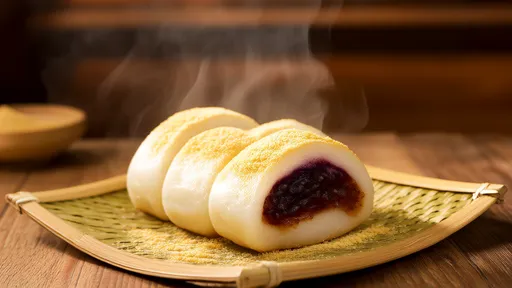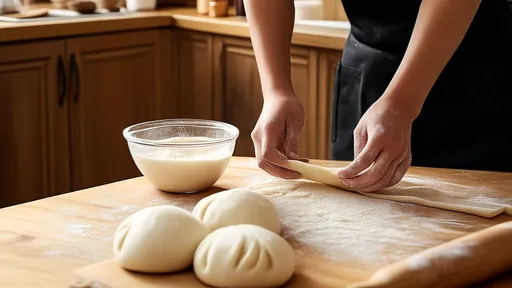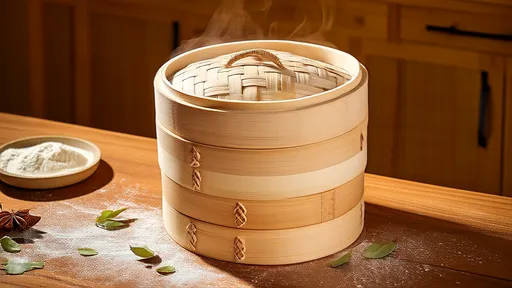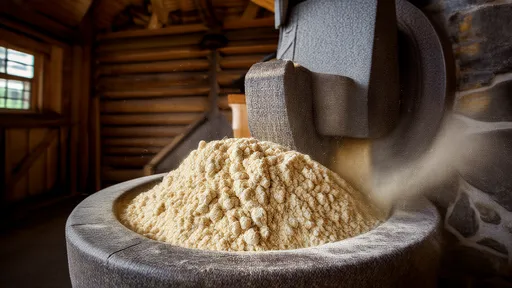The art of crafting perfect hand-pulled noodles lies in mastering the delicate balance between gluten development and dough relaxation. Among the many variables that influence noodle extensibility, resting time stands as one of the most critical yet often overlooked factors. This silent alchemy occurring during the waiting period transforms a stiff, unyielding mass into an elastic, cooperative material ready to be stretched into silky strands.
When flour meets water, gluten proteins begin their slow dance of hydration and alignment. Initially, these proteins resemble tangled threads resisting organization. The first few minutes of kneading create mechanical stress that forces glutenin and gliadin molecules to interact, forming the rudimentary gluten network. However, this early structure remains brittle and prone to tearing when subjected to the vigorous pulling required for traditional lamian. Here lies the paradox of noodle dough – maximum strength doesn't equate to optimal extensibility.
Professional noodle masters speak of dough having its own rhythm, a biological clock that dictates when it reaches peak workability. During resting periods, the hydrated gluten undergoes subtle rearrangements at the molecular level. Disulfide bonds break and reform in more favorable configurations, while hydrogen bonds continuously shift to relieve internal stresses. This molecular ballet occurs most efficiently when the dough sits undisturbed, allowing time to work its magic where brute force cannot.
The temperature plays a fascinating supporting role in this process. In cooler kitchen environments, the resting period naturally extends as molecular movement slows. Some artisans exploit this by refrigerating dough overnight, resulting in exceptionally uniform gluten development. Conversely, warmer conditions accelerate hydration but may lead to uneven structuring if not carefully monitored. The ideal range for most traditional recipes falls between 20-24°C, creating what noodle makers call the sweet spot for balanced development.
Regional variations in resting practices reveal cultural wisdom passed through generations. In Lanzhou, the epicenter of Chinese hand-pulled noodles, masters typically divide the resting into multiple stages. After initial kneading, the dough rests wrapped in damp cloth for 15-20 minutes, followed by brief re-kneading and another 30-minute pause. This stop-and-go approach allows for gradual stress relaxation while maintaining dough temperature consistency. Shanxi noodle artisans, famous for their knife-cut varieties, often employ marathon resting sessions of 2-3 hours to achieve different textural goals.
Scientifically, the transformation during resting can be measured through rheological testing. A well-rested dough exhibits higher strain hardening index values, meaning it resists thinning during stretching until the final moments before separation. This quality proves essential when pulling noodles to extreme lengths – some masters can stretch a single portion over three meters without breakage. Microscopic analysis reveals how properly rested dough develops a gluten matrix resembling a three-dimensional fishnet, with enough give for expansion but sufficient strength to maintain integrity.
The relationship between resting time and water absorption creates another layer of complexity. Higher hydration doughs (around 38-42% water by flour weight) require longer resting as water molecules take more time to fully penetrate and organize the protein structure. However, exceeding certain hydration thresholds without adjusting resting time leads to sticky, unmanageable dough. Experienced noodle makers judge readiness not by the clock alone, but by the dough's response to gentle finger pressure – it should slowly bounce back while retaining a slight indentation.
Commercial noodle production faces unique challenges in managing resting periods. While small shops can afford to let dough rest naturally, large-scale operations often employ controlled proofing chambers that regulate temperature and humidity. Some manufacturers experiment with enzymatic additives to accelerate gluten development, though purists argue this sacrifices the nuanced texture achieved through traditional methods. The most successful industrial producers strike a compromise – extending resting times slightly beyond minimum requirements while maintaining efficient workflow.
Modern food science continues to unravel why time affects gluten so profoundly. Recent studies suggest that during resting, water molecules not only hydrate proteins but also facilitate the migration of lipids that naturally occur in flour to the gluten network's surface. This creates a subtle lubricating effect that becomes apparent during the pulling process. Additionally, the gradual pH changes occurring in undisturbed dough contribute to improved extensibility, though the exact mechanisms remain under investigation.
For home cooks attempting hand-pulled noodles, patience proves the most difficult ingredient to master. The temptation to rush the process often leads to torn noodles and frustration. A reliable guideline suggests minimum 30 minutes resting for basic recipes, with noticeable improvement up to 90 minutes. Wrapping the dough tightly in plastic prevents surface drying, while light oil coating can ease later handling. The reward for this waiting game becomes evident when the dough suddenly transforms from resistant to supple, stretching like edible silk under practiced hands.
Beyond technical considerations, the resting period holds cultural significance in noodle-making traditions. Many artisans view this quiet interval as meditation time, a pause between the vigorous kneading and the dramatic pulling performance. In some workshops, the rhythmic sounds of dough slapping against countertops cease during resting, creating a palpable anticipation for the transformation about to occur. This interplay between action and inaction mirrors larger philosophical concepts in East Asian cultures, where emptiness holds as much importance as substance.
As global interest in authentic noodle techniques grows, understanding these subtle aspects becomes increasingly valuable. The difference between good noodles and extraordinary ones often lies not in the visible skills of stretching and twisting, but in the invisible molecular changes occurring during those quiet resting moments. Whether in a bustling Lanzhou noodle shop or a home kitchen halfway across the world, respecting the dough's need for time remains the universal secret to achieving that perfect chew, that ideal balance between tenderness and resilience that defines great hand-pulled noodles.
The art of baking a perfect cake relies heavily on understanding the science behind its structure. Among the many factors that contribute to a cake's texture, the uniformity of air pockets within the cake crumb stands out as a critical element. This characteristic is largely influenced by the foaming properties of proteins in the batter, particularly those found in eggs. The way proteins trap and stabilize air bubbles during mixing directly impacts the final product's lightness, tenderness, and overall mouthfeel.
The world of sensory evaluation is as intricate as it is fascinating, particularly when it comes to understanding how we perceive flavors and aromas. Among the myriad of compounds that contribute to our sensory experiences, vanillin—the primary component of vanilla extract—stands out for its widespread use and complex interaction with our senses. The concept of odor threshold plays a pivotal role in determining how much of this compound is needed for it to be detectable, and it varies significantly depending on the medium in which it is presented.
The world of chili peppers is as diverse as it is fiery, with each variety packing its own unique punch. At the heart of understanding this heat lies the Scoville Scale, a measurement that quantifies the spiciness of peppers. Developed by Wilbur Scoville in 1912, this scale remains the gold standard for gauging the capsaicin content—the compound responsible for that burning sensation—in different peppers. From the mild bell pepper to the mind-numbing Carolina Reaper, the Scoville Scale offers a fascinating glimpse into the spectrum of heat that chili enthusiasts chase.
The culinary world has long celebrated the magic that happens when certain ingredients come together, creating flavors greater than the sum of their parts. One such pairing—chicken broth and mushrooms—exemplifies the scientific and gastronomic phenomenon known as umami synergy. This dynamic duo has been a staple in kitchens across cultures, from French consommé to Japanese ramen, and its power lies in the way their compounds interact to amplify savory depth.
The world of fermented foods is a fascinating intersection of microbiology, chemistry, and culinary tradition. Among these, kimchi stands out not only for its bold flavors but also for the intricate biochemical processes that transform raw vegetables into a probiotic-rich delicacy. At the heart of this transformation lies a phenomenon known as acetic acid penetration, which creates a dynamic pH gradient during fermentation. This process is far more than a simple souring of cabbage—it's a carefully orchestrated dance between microbial communities and their chemical environment.
The turbidity of fruit juice, often perceived as a mark of freshness and natural quality, is primarily governed by the suspension mechanisms of pulp particles. These tiny fragments of fruit flesh, ranging from cellular debris to larger fibrous clusters, create the characteristic cloudiness that consumers associate with premium products. Behind this seemingly simple phenomenon lies a complex interplay of physical forces, biochemical interactions, and processing variables that determine whether pulp remains evenly dispersed or separates over time.
The fizz in your soda isn't just about taste—it's a carefully engineered dance between gas and liquid that begins unraveling the moment you twist open the cap. Few consumers realize how precisely carbonation levels are calibrated, or how dramatically pressure dynamics shift during that first explosive release. This invisible physics experiment in every bottle follows predictable but fascinating patterns that beverage scientists have spent decades mapping.
The world of espresso is as complex as it is captivating, with its rich flavors and aromatic allure. At the heart of this complexity lies a seemingly simple yet scientifically intricate component: the crema. This golden-brown layer of foam that crowns a well-pulled shot of espresso is not just a visual delight but a fascinating study in colloidal stability. The interplay of oils, gases, and solids in espresso crema reveals a delicate balance that defines the quality and texture of the coffee.
The phenomenon of "cold turbidity" or "cream down" in tea has long intrigued both tea connoisseurs and scientists alike. This natural occurrence, where tea liquor turns cloudy upon cooling, is not merely an aesthetic curiosity but a window into the complex chemistry of tea. Recent advancements in optical measurement techniques have enabled researchers to quantify this phenomenon through turbidity detection based on tea liquor transmittance, opening new avenues for quality assessment and understanding of tea's molecular interactions.
The world of instant noodles thrives on convenience, but behind that simplicity lies a carefully engineered marvel of food science. At the heart of this innovation sits pregelatinized starch—an unsung hero that transforms dehydrated noodles into a steaming bowl of comfort within minutes. Unlike traditional starch, pregelatinized starch undergoes a thermal and mechanical treatment that breaks down its granular structure, allowing it to absorb water rapidly. This property is pivotal for instant noodles, where rehydration speed and texture determine consumer satisfaction.
The world of traditional fermented foods holds countless microbial secrets, and few are as fascinating as the complex ecosystem of laomian – the centuries-old sourdough starter that gives Chinese steamed bread its distinctive character. While modern bakeries increasingly rely on commercial yeast, artisanal producers across northern China still maintain their family laomian cultures like precious heirlooms, passing down not just techniques but living microbial communities through generations.
The sticky, chewy texture of glutinous rice cakes, known as mochi in Japanese or nuòmǐ cí in Chinese, has long been a staple in East Asian cuisine. These delectable treats, often enjoyed during festivals or as everyday snacks, owe their unique consistency to a key component: amylopectin, the branched-chain starch found in glutinous rice. However, anyone who has left mochi or Chinese mochi cakes (糍粑) at room temperature for a few hours will notice an unmistakable transformation—the once-soft and pliable dessert gradually hardens, becoming tougher and less enjoyable. This phenomenon, often referred to as retrogradation, is a fascinating interplay of chemistry, physics, and culinary science.
The art of cooking perfect rice lies in understanding the gelatinization temperature of different japonica rice varieties. This scientific parameter, often overlooked by home cooks, determines the precise moment when starch granules absorb water and swell—fundamentally shaping texture, flavor release, and nutritional accessibility. Recent studies across Asian research institutions reveal how subtle genetic variations in short-grain rice cultivars create distinct thermal behaviors during cooking, challenging the one-size-fits-all approach to water ratios and heat application.
The art of crafting perfect hand-pulled noodles lies in mastering the delicate balance between gluten development and dough relaxation. Among the many variables that influence noodle extensibility, resting time stands as one of the most critical yet often overlooked factors. This silent alchemy occurring during the waiting period transforms a stiff, unyielding mass into an elastic, cooperative material ready to be stretched into silky strands.
For generations, home cooks and professional chefs alike have relied on stainless steel containers for pickling and food storage. The material's reputation for durability and corrosion resistance makes it a seemingly ideal choice. But when acidic ingredients like vinegar enter the equation, questions arise about potential metal leaching and food safety. Understanding the interaction between stainless steel and pickling brines requires a deeper dive into metallurgy, chemistry, and culinary science.
The bamboo steamer, a centuries-old culinary tool cherished across Asian kitchens, operates on principles far more sophisticated than its simple appearance suggests. Among its most fascinating phenomena is the so-called "bamboo steamer effect" – a self-regulating mechanism that prevents the dreaded condensation drip-back, ensuring perfectly textured dumplings, buns, and fish every time. This natural engineering marvel has captivated chefs and scientists alike, revealing how traditional wisdom often anticipates modern food science.
The age-old practice of stone milling has long been revered for its ability to produce flour that retains the natural goodness of whole grains. Unlike modern industrial milling methods, which often prioritize speed and shelf life, stone grinding operates at a slower pace, preserving the integrity of the grain’s nutritional profile. One of the most significant advantages of this traditional method is its ability to maintain higher levels of dietary fiber in whole wheat flour—a component essential for digestive health, blood sugar regulation, and overall well-being.
















